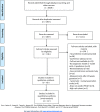Systematic review of prediction models for gestational hypertension and preeclampsia
- PMID: 32315307
- PMCID: PMC7173928
- DOI: 10.1371/journal.pone.0230955
Systematic review of prediction models for gestational hypertension and preeclampsia
Abstract
Introduction: Prediction models for gestational hypertension and preeclampsia have been developed with data and assumptions from developed countries. Their suitability and application for low resource settings have not been tested. This review aimed to identify and assess the methodological quality of prediction models for gestational hypertension and pre-eclampsia with reference to their application in low resource settings.
Methods: Using combinations of keywords for gestational hypertension, preeclampsia and prediction models seven databases were searched to identify prediction models developed with maternal data obtained before 20 weeks of pregnancy and including at least three predictors (Prospero registration CRD 42017078786). Prediction model characteristics and performance measures were extracted using the CHARMS, STROBE and TRIPOD checklists. The National Institute of Health quality assessment tools for observational cohort and cross-sectional studies were used for study quality appraisal.
Results: We retrieved 8,309 articles out of which 40 articles were eligible for review. Seventy-seven percent of all the prediction models combined biomarkers with maternal clinical characteristics. Biomarkers used as predictors in most models were pregnancy associated plasma protein-A (PAPP-A) and placental growth factor (PlGF). Only five studies were conducted in a low-and middle income country.
Conclusions: Most of the studies evaluated did not completely follow the CHARMS, TRIPOD and STROBE guidelines in prediction model development and reporting. Adherence to these guidelines will improve prediction modelling studies and subsequent application of prediction models in clinical practice. Prediction models using maternal characteristics, with good discrimination and calibration, should be externally validated for use in low and middle income countries where biomarker assays are not routinely available.
Conflict of interest statement
The authors have declared that no competing interests exist.
Figures
References
-
- WHO, UNICEF, UNFPA, The World Bank and the United Nations Population Division. Trends in maternal mortality: 1990 to 2013. Estimates by WHO, UNICEF, UNFPA, The World bank and the United Nations Population Division. 2014 Available from: www.who.int
-
- Bujold E, Roberge S, Lacasse Y, Bureau M, Audibert F, Marcoux S, et al. Prevention of Preeclampsia and Intrauterine Growth Restriction With Aspirin Started in Early Pregnancy. Obstet Gynecol. 2010. August;116(2, Part 1):402–14. - PubMed
Publication types
MeSH terms
Substances
LinkOut - more resources
Full Text Sources
Medical
Miscellaneous





